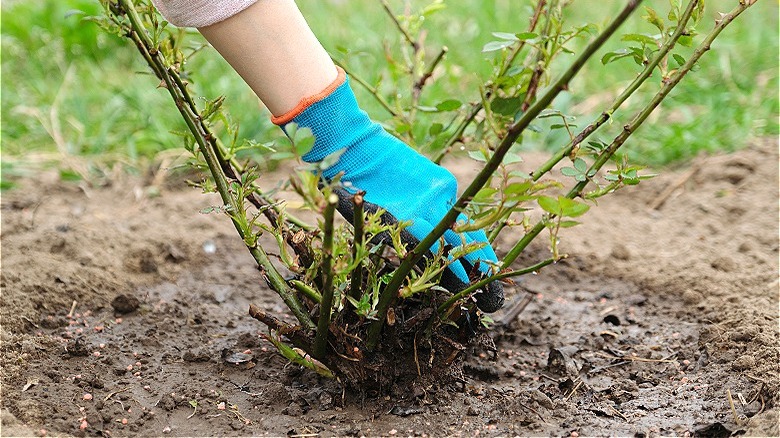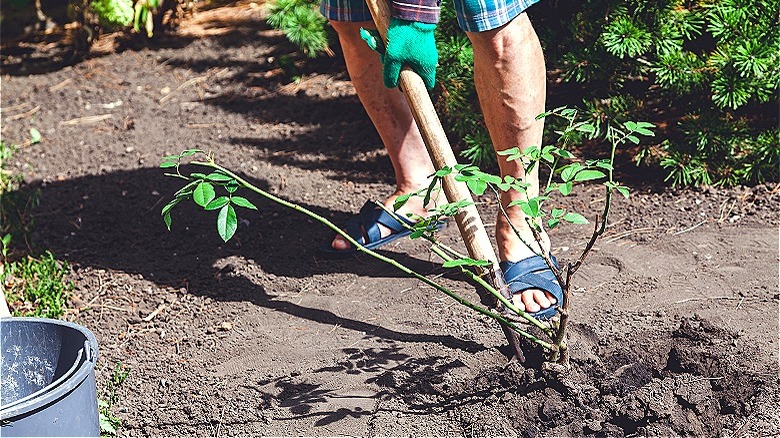Garden Trees, Shrubs & Vines
Sandy Baker
It’s given you lots of beautiful blooms over the years, but now that rose bush in your garden is overgrown, struggling to thrive, or simply in the way of the landscape you’re trying to create. Removing a rose bush, with a bit of kindness even, is possible, and it doesn’t have to be too difficult either if you know how to maximize the effort you put into the process. The key to getting a rose bush out of your yard is removing as much of the root ball as possible.
Often, if you take the time to carefully remove a rose bush from the ground, you’ll be able to transplant it to a new location that may work better for your landscaping. However, if this is your goal, it’s best to do so during the growing season rather than when the rose bush is dormant, such as in the late fall and winter months. That’s going to encourage the roots to grow in the new environment.
Let’s assume, though, that your goal is to remove the rose bush from your yard without too much thought of replanting it. If that’s the case, you’ll need to first weaken it, dig it out fully, and remove all the leftover components. Doing this ensures the roots don’t get in the way of other plants later.
Weakening the rose bush gives you the advantage

Valeriy_g/Getty Images
When it comes to gardening advice, it isn’t common to be told to weaken a plant. However, that’s exactly what to consider here for your rose bush. To remove a rose bush, start with a sharp pair of pruning shears and cut back as much of the bush as possible. Doing this helps to minimize the amount of growth the plant has moving forward. You’ll also want to ensure you’re cutting off all water to the plant. This will cause the rose plant to dry out significantly, making your job easier.
For those who don’t have a lot of muscle power, weakening the plant first is a good way to make removal easier to do. If you do this a few weeks before digging out the rose bush’s root ball, the plant will be at a much higher risk of pest and disease infestation while also being dryer. That’s going to weaken the roots and make the entire bush easier to manage. If you have the right tools and muscle power behind you, you don’t need to wait that long to remove the bush.
If you plan to transplant the rose bush instead of killing it, you’ll need to skip these steps. Transplant work is a bit more challenging, but protecting the branches, leaves, and roots is necessary to give the plant the best chance to thrive.
Digging out a rose bush properly for removal

glebchik/Shutterstock
The night before you plan to remove your rose bush, saturate the soil around the plant with water. This will help to loosen it from the tight grip it has on the soil while allowing some of the water to drain away to keep it from clumping up.
To fully remove the rose bush from your yard, dig around the exterior of the plant’s base, at least as wide as the branches fan out. Use a sharp spade to help with this process. Move around the base of the plant in a circle by pushing the spade into the ground as far as possible and then pulling up the dirt. Once you do this around the base, the root ball will become visible. Keep working around the bush until you can see all of the ball-like structure.
The roots will come from that ball and spread into the ground under and around the plant. You will be cutting through some of them. Some rose bushes can have roots that extend as far as several feet into the ground below.
If you’re aiming just to kill the plant, cutting into the root ball and removing only about a foot of the roots should make it impossible for the plant to grow again. Unless you plan to plant something else in this area, you’ll be able to leave the very bottom of the root system in place and cover it with soil.




